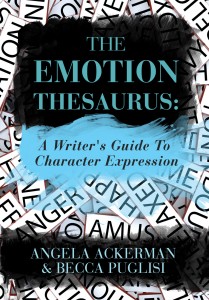 When Angela Ackerman and I started The Bookshelf Muse back in 2008, we had no intention of turning its content into a book. Mostly, we just wanted to help and encourage other writers. As critique partners, we knew that our characters tended to repeat body cues for certain emotions (mine were always shifting their feet and narrowing their eyes; Angela ’s characters had lip-biting and frowning fetishes). We figured that if we were struggling in this area, then other writers probably were, too. So for our blog, we decided to start an Emotion Thesaurus, sharing one emotion a week that focused on the different cues writers could use to express that emotion. The idea was to offer up needed content in a way that would keep readers coming back for more.
When Angela Ackerman and I started The Bookshelf Muse back in 2008, we had no intention of turning its content into a book. Mostly, we just wanted to help and encourage other writers. As critique partners, we knew that our characters tended to repeat body cues for certain emotions (mine were always shifting their feet and narrowing their eyes; Angela ’s characters had lip-biting and frowning fetishes). We figured that if we were struggling in this area, then other writers probably were, too. So for our blog, we decided to start an Emotion Thesaurus, sharing one emotion a week that focused on the different cues writers could use to express that emotion. The idea was to offer up needed content in a way that would keep readers coming back for more.
After six months, we had forty emotions and a couple hundred followers, most of whom seemed pleased with the content. But by this point, Angela and I needed something fresh, so we went back to our own writing to find another area of common struggle: setting description. We followed the same one-entry-a-week format and soon had an extensive Setting Thesaurus, as well.
Fast forward four years and five more thesauri. Our loyal followers (then nearing the 3,000 mark) started commenting about how convenient it would be to have the blog’s thesaurus content in handy book form. We heard it over and over again; after awhile, the idea began to sink in. So we started with the Emotion Thesaurus, which was the most popular. We began looking into traditional publishers, because that’s the route we’d always envisioned for our personal fiction writing careers. But we soon saw some problems with that plan. First off, we knew that any traditional publisher would require us to remove all existing thesaurus content from the blog. This wasn’t an option for us. We wanted to maintain our brand of writers helping writers, and removing the content altogether was a deal breaker. Another issue was time. Going the traditional route would take at least two years before the book would be available for purchase. We had inadvertently stumbled into a niche area with this content, and we knew that it was only a matter of time before someone else published something like it. So two years was too long to wait. Lastly, thanks to the blog, we already had a built-in platform of followers who were literally clamoring to buy our book. For all of these reasons, it became obvious that self-publishing was a good option for us.
In January of 2012, we started the process of converting our blog content into a manuscript. While time-consuming, it wasn’t too difficult. The bones of the book were there; they just needed smoothing and polishing (and a bit of new content) to turn our informal blog entries into a cohesive resource book.
Still, our April launch date got pushed back to May, and even that was almost too ambitious, but not because of writing setbacks. A lot of steps in the publishing process took longer than we anticipated, like setting up an international business (Angela’s Canadian and I live in the US), issues with the formatting, and a glitch at one our distributors that took awhile to fix. Luckily, we did manage to launch in May. Thanks to our loyal friends and followers, an aggressive marketing plan, and a lot of word-of-mouth, we’ve now sold 13,000 copies of The Emotion Thesaurus: A Writer’s Guide to Character Expression and are currently drafting our next thesaurus, which will (hopefully) be released in the spring of 2013.
The ride has been awesome and bewildering and 100% worthwhile. Looking back on the process, there are definitely some take-aways for anyone considering writing a booked blog.
First, choose your content wisely. To maximize the possibility of your blogged words being one day publishable, choose content that:
- is fresh and unique.
- is in demand (be it fiction writing or a non-fiction resource).
- draws your intended audience to your blog.
Second, when deciding whether to go the traditional or self-publishing route, do your research and make an informed decision on what’s best for you and your project. Some factors to consider:
- Creative Control. How much do you need? How much are you willing to give up?
- Time. Do you have the time to commit to researching agents/publishers, building a brand and audience, and marketing completely on your own?
- Discipline. Can you look objectively at your work and not publish it until it’s the best it can possibly be, or would you prefer to have an agent’s/editor’s input to help you decide?
- Finances. Do you have money to invest in up-front expenses for self-publishing? Which route will net you more profit, and how important is that to you?
Third, know that the learning process doesn’t stop once the book is published. Situations and opportunities will always be arising that you’ll have to evaluate and decide how to handle: marketing requests from fellow writers, requests for endorsements, negative reviews, unexplored social media platforms, etc. As authors, we put so much work into the actual book and its publication; it’s easy to think that once the book is out there, we can relax. The opposite is actually true. While some downtime is definitely deserved and needed, know that to be successful, you’ll have to keep researching those opportunities that cross your path, keep evaluating what’s working and what’s not, keep exploring new avenues. If you know ahead of time that this is part of the post-publication journey, it will be easier to accept once you get there.
Angela and I are so stoked, and quite awed, at how well The Emotion Thesaurus is doing. We started this process knowing next to nothing, and we’re still figuring some things out (see point #3). Regardless, we feel very blessed to have our names on this book that is helping so many writers. I’m always happy to discuss our journey and share information, so if anyone has questions, please do leave them in the comments.
Becca Puglisi is one half of The Bookshelf Muse blogging duo, and co-author of The Emotion Thesaurus: A Writer’s Guide To Character Expression. Listing the body language, visceral reactions and thoughts associated with 75 different emotions, this brainstorming guide is a valuable tool for showing, not telling, emotion. The Emotion Thesaurus is available for purchase through Amazon, Barnes & Noble, iTunes, and Smashwords, and the PDF can be purchased directly from her blog.


Thanks for giving me the opportunity to share our story, Nina. It’s been such an interesting and unexpected ride!
Thank you for the great post, Becca! My readers can learn so much from your journey.
I think I’ve become a little too dependent on The Emotion Thesaurus! It’s always helped me in my time of need, and I’m glad to hear it’s been so successful for you!